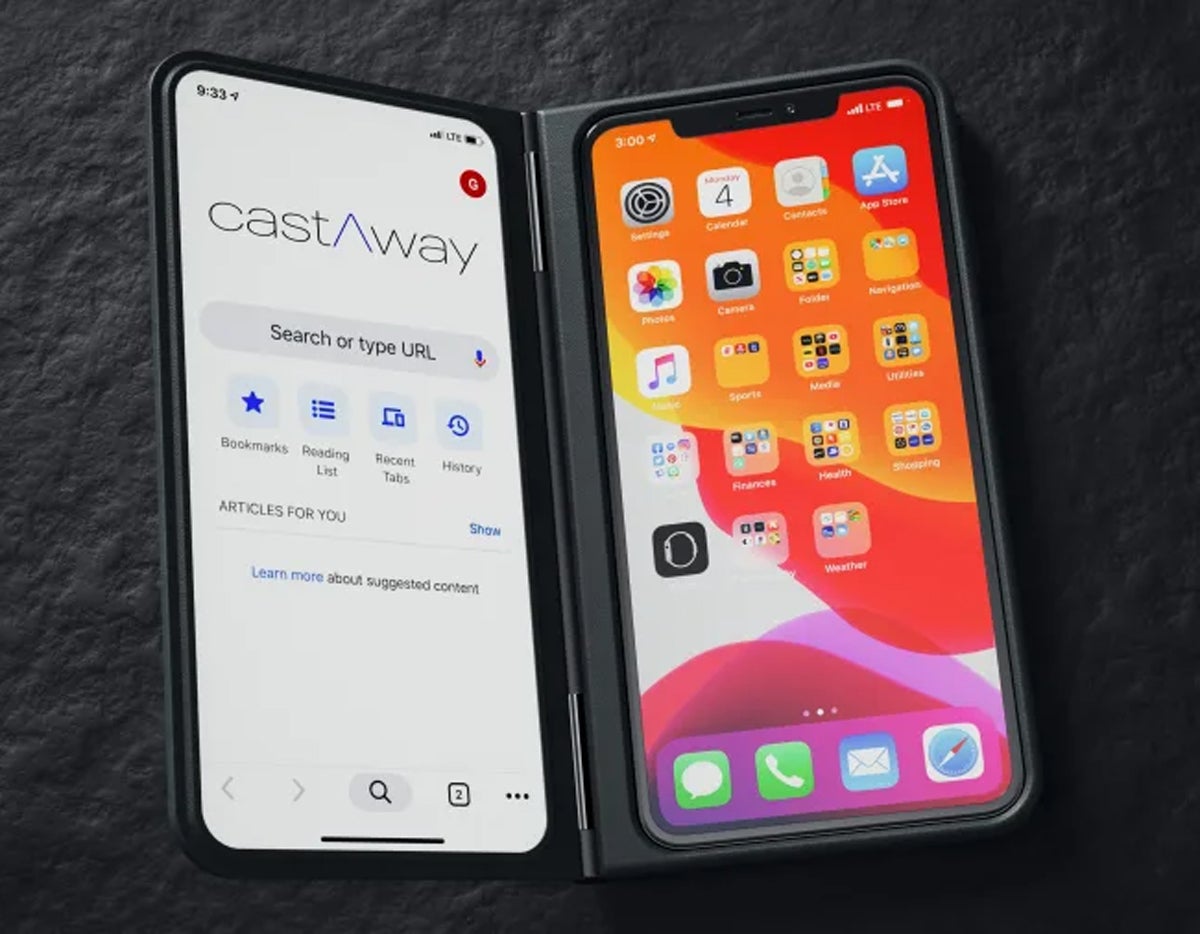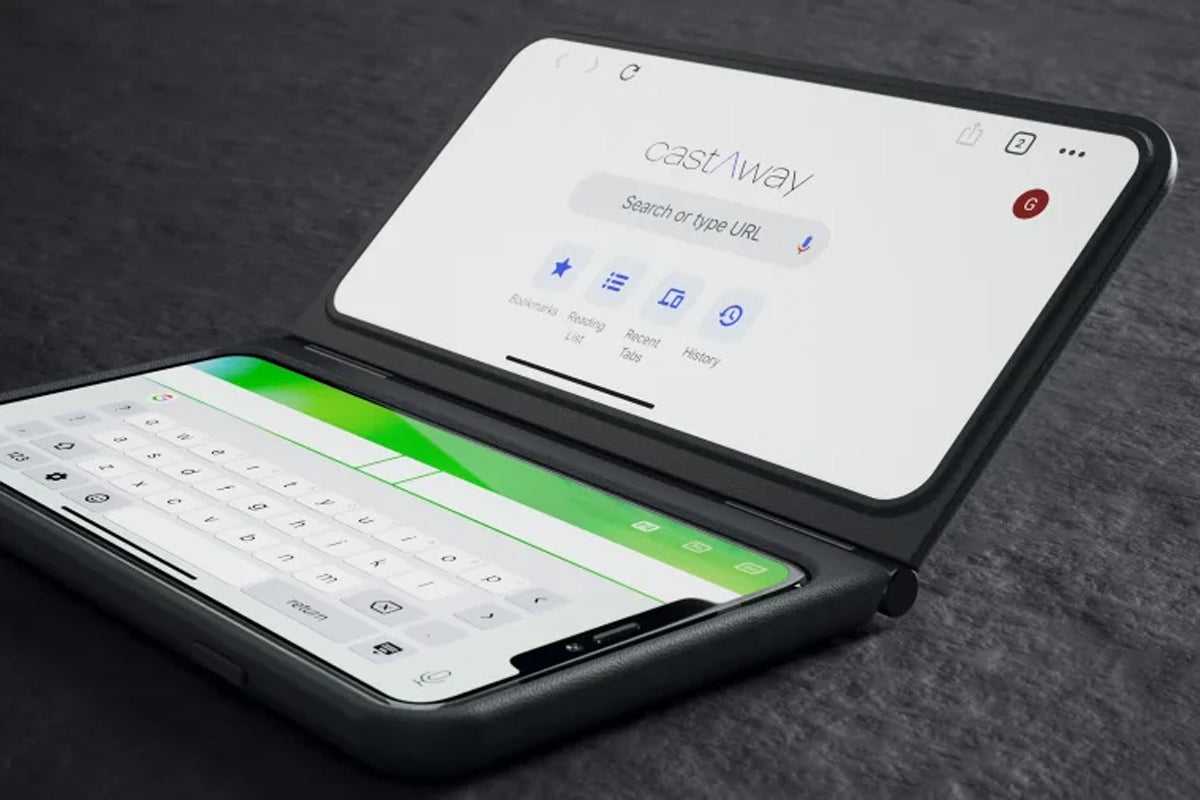We've been talking for ages now about the intersection of Chrome OS and Android and the endless ways Google's two primary platforms work together.
For all of the overlap, though, Chrome OS and Android have never actually coexisted within the framework of a single device — living side by side on a multipart system, in other words, and acting as complementary halves of a unified experience. But if one ambitious inventor gets his way, that may be about to change.
The guy's name is Ken Mages, and he's come up with a product known as the CastAway. It's described as a "second screen for your smartphone" — one that runs Chrome-OS-like software and puts "the world's smallest Chromebook" right alongside your phone.
The CastAway popped up on Indiegogo last week and has been getting a fair amount of attention ever since, with around 800 people backing the project for a total of nearly $140,000 in funding as of this moment. (The project's original goal was a much more modest $50,000.)
The concept was immediately intriguing to me, as you can imagine, but I had lots of questions — questions about how this whole thing would actually work, if and how it'd actually be useful, and, critically, if and when we'd actually see it in production.
So rather than simply speculate, I decided to sit down with its creator to get some answers. Android Intelligence Platinum members can listen to our conversation as a special bonus episode of my weekly podcast. Here, meanwhile, are 10 interesting things I learned from our chat.
1. At its core, the CastAway is actually just a tiny tablet that runs Chromium.
It's easiest to talk about this product as using Chrome OS and being like a Chromebook, but technically, what it actually uses is Chromium — the open-source version of Chrome OS that's developed by Google and freely available for anyone to grab. You can think of it kind of like Chrome OS without Google's proprietary layer of apps and services. It's the cake, in a sense, without the icing. And that has some significant implications, which we'll talk more about in a moment.
The device itself is a standalone slate that doesn't need a phone to operate. It'll come with a 5.8" or 6.3" screen and a case that puts it side by side with your phone, with a 360-degree detachable hinge between 'em — but there's no physical connection between the CastAway and your phone, and the case itself is literally just a case.
 CastAway
CastAway 2. The interaction between the CastAway and your phone revolves around a custom app.
Mages and his team are finishing up work on an app that'll allow the CastAway to interact with both Android and iOS devices via a direct Wi-Fi or Bluetooth connection.
The app will serve two primary purposes: First, on the phone side, an Android or iOS version of it will create a series of folders. Any images or files you open while the CastAway is connected will be copied into one of those folders. Then, on the CastAway side, a custom Chrome extension will be alerted to any activity within those folders — and anytime something new appears, the extension will grab it and bring it over to the CastAway so you can access it there.
That means if you take a photo on your phone while the app is running and the CastAway is connected, the photo will show up on the CastAway a second later — where you can view, edit, or manipulate it as needed.
"It almost happens in real-time," Mages says.
The app's second purpose is to serve as a clipboard where you can paste anything — text, photos, videos, or any other sorts of files — and have that content immediately copied and pasted over to the CastAway (or vice-versa).
3. The CastAway can also boot into a separate mode that allows it to act as a Bluetooth keyboard and trackpad.
In addition to its Chromium capabilities, you'll be able to boot the CastAway into a special mode in which its screen serves solely as a Bluetooth input surface. Mages is still working out the specifics but says it's likely to be a longer press of the power button — pressing and holding it down for somewhere around five seconds — that'll trigger this secondary mode.
And being that it's a purely Bluetooth-based function, the CastAway's keyboard and trackpad function will work with any Bluetooth-compatible device, be it a phone, a tablet, or even a laptop or desktop computer.
4. The idea for the CastAway came from its creator's own unusual setup.
Mages has long used Chromebooks alongside his smartphone. Over the years, he tells me, he came up with some crafty hacks to make the two work together.
"I've developed my own techniques and written some code of my own and had some code written professionally to make the two sympatico," he says. "One would not think that that was a logical pairing, but you can actually do quite a lot in terms of making them work in a friendly way together."
That experience led him to come up with the idea of a case that'd bring the two platforms together — in a portable form that he could then carry with him and continue to rely upon even when his full-sized computer wasn't present.
"I didn't want to carry my Chromebook around all the time. I wanted it next to my iPhone," he says.
5. The CastAway runs Chromium instead of Android mostly because of the simplicity and versatility that software provides.
Mages was "looking for the best can-opener," as he explains it, and quickly realized that Chromium had the potential to make things "just work" in a way other open-source operating systems wouldn't allow.
"When you're running the Chrome browser on Android or on iOS, you're really running into restrictions that are imposed by Android or by iOS — that mostly surround digital rights management," he says, pointing to the example of how opening Netflix in a smartphone browser will prompt you to download the Netflix app, whereas opening it in on a Chromebook will let you sign in and stream video right then and there.
And that same sort of logic applies to other areas where Mages wanted things to work without any extra action or thought on the user's behalf.
"I like the fact that Chrome OS, if you throw a file at it ... whatever you throw at it, it'll know how to open it," he says. "It won't say, 'Go get another app' — it'll just do it."
6. The CastAway can run Android apps, but it seems to rely on an unofficial workaround.
Android app support is typically a feature that's limited to Chrome OS and not available to anyone using the open-source Chromium code. The reason is that the presence of the Play Store relies upon specific Google elements and licensing — something that's also true on the Android side of the fence (as we were reminded with the whole recent Huawei-Google app fiasco).
And yet, well...
"We found a way to get it to work," Mages tells me. "Whether Google's going to like that, love that, or hate that is a TBD."
Mages' hope is that the CastAway's relatively low volume will let the product fly under the radar, but only time will tell. For now, I'll say this: Having a core advertised feature of a product relying on an unofficial workaround would certainly make me a little nervous.
7. The CastAway team modified other parts of the Chromium code to allow certain things, like Netflix, to operate.
One thing that jumped out at me during our conversation was Mages' mentioning of support for Netflix streaming on the CastAway device. That's because of my experience with another company that uses the open-source Chromium code, Neverware — an organization we've talked about in these quarters before. Neverware, as you may recall, maintains a freely available Chrome-OS-like operating system for folks to install on old Windows or Mac laptops in order to give 'em new life.
But there are some catches — including the fact that Neverware's software, as I discovered while evaluating it a few years back, didn't allow you to use Netflix. That's because Netflix support isn't instant or automatic, and Google itself had to work out an arrangement to make Chrome OS compatible with the service's streaming requirements. That, however, is all part of the proprietary Google layer that isn't available in the open-source Chromium version.
(Update: Neverware actually does now natively support Netflix streaming, as the result of an integration of the same digital-rights-management module Google maintains for use in its official Chromebooks. That integration took place last summer; the company had made the module available as an optional plugin starting the prior year.)
So how does CastAway allow Netflix streaming, then? Again, the answer seems to be by way of a workaround.
"We certainly have gone in and modified the architecture of Chromium to the extent that we needed to, to make sure that all the functions we needed would work," Mages says.
And again, it's hard not to wonder if this will end up ruffling the wrong feathers once CastAway progresses past the prototype phase and becomes an actual selling product. For now, at least, though, that's how this impossible-seeming function exists.
8. One big question mark right now is how operating system updates will play out.
Google's Chrome OS upgrades are fast, frequent, and full of both security fixes and feature expansions — but Google only rolls the software out to actual Chromebooks that use its license-requiring, fully finished software. Anyone using the open-source Chromium code, in contrast, is responsible for retrieving every update that comes along and then processing it and sending it out on their own.
Given how important we know these updates can be — and how frequently they're delivered — that left me wondering what the plan was for keeping the CastAway up to date in the months and years after its release.
The answer, it seems, is that it's still uncertain.
Mages tells me he's currently "in conversations" with Neverware — the company we just talked about a second ago — to see if it could handle the CastAway's updates through its own well-oiled rollout system. But that option is "pricey," Mages says, and doesn't scale to the CastAway's current low volume.
The other option being considered is trying to work out some sort of arrangement directly with Google to have it assist with the CastAway's updates — but, well, it's tough to envision a scenario where that would realistically happen outside of the CastAway becoming a fully certified, formal Chromebook (which would obviously entail a pretty substantial shift from its current positioning).
The one thing that's certain, Mages says, is that managing the pace of OS updates without some sort of external assistance would be "too much" for his current team to handle.
9. Mages is confident the CastAway will actually ship.
If there's one million-dollar question with any crowd-funded hardware product, it's the plain and simple reality check: Will we ever actually see this thing?
After all, we've certainly all heard about our share of promising-sounding projects that launched to great fanfare on Indiegogo, Kickstarter, or other such services and then failed to come to fruition. Mages is well aware of this, and he says he completely understands the need for skepticism. But he also says this is a professional, serious effort — put together by an experienced team, including former Microsoft and Intel executives and a former Dell design director — and that he's 100% confident the product will, in fact, ship.
"One guy this morning got on Facebook and said, 'I'll bet anyone here on Facebook a thousand dollars at this product won't deliver in May,'" he tells me. "I got on and said, 'I'll put a thousand dollars in escrow right now and take that bet.'" (The person didn't take him up on the offer.)
Right now, Mages tells me, the main goal is to reach a volume where the cost of materials is low enough for production to be feasible. But he and his colleagues are "well on the road" to the manufacturing phase, he says, and are working hard to meet their stated May 2020 goal for shipping.
10. The ultimate hope is to position the CastAway to create a network that can be used for 5G access — and for advertising.
Make no mistake about it: Mages and his team have ambitions for this device that stretch far beyond its current form. They revolve around the idea of using the product to create a global network with its own profit-creating possibilities.
That network would function on two different fronts — the first of which would be providing carriers with a way to sell a simple 5G add-on for existing 4G phones.
"If the 5G resides on the Chromebook side, you now have 5G access," Mages says. "So let's assume my second-gen device does have a SIM card. Now you don't need to go get a 5G phone that'll cost two grand."
The second front involves using that network of devices to — wait for it — sell ads that'd appear on the CastAway screen.
"When I get to some critical mass number ... I will have a network that I can control through my Multitask+ app," Mages says.
The hope, then, would be to let advertisers pay for the ability to have their promotions pushed through the Multitask+ app and featured on CastAway screens everywhere. That'd happen only if a device's owner explicitly opted into the program, Mages assures me — a proposition that could eventually allow customers to get the device for free if they agree to watch a certain number of ads per month.
"I call that 'back-of-the-phone advertising' — because nobody's using that space. It's like a billboard on the road that everyone passes by and nobody's got an ad on it," he says.
And that, ultimately, brings us full-circle — and back to the underlying role of this initial gadget.
"I can't talk about my ambitions about creating a network unless I have critical mass, and I can't get to critical mass without an Indiegogo campaign that says, 'Yeah, I'm interested in this,'" Mages explains. "The Indiegogo thing will tell me in 44 days if 1,000, 10,000, or 100,000 people are interested."
You can listen to my conversation with Ken Mages in a special bonus episode of my Android Intelligence Platinum podcast — and you can see more about the CastAway on the product's official Indiegogo page.
Sign up for my weekly newsletter to get more practical tips, personal recommendations, and plain-English perspective on the news that matters.

[Android Intelligence videos at Computerworld]














